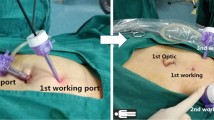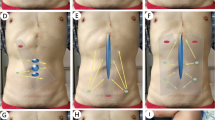Summary
Background
Laparoscopic and robotic extraperitoneal ventral hernia repair techniques have developed with the goal of combining the benefits of traditional open sublay repair with those of minimally invasive surgery. We describe the use of a laparoendoscopic extraperitoneal sublay repair employing a linear stapler for plication and division of the linea alba with subsequent mesh augmentation.
Methods
Between January 2016 and February 2017, 21 patients with midline ventral and incisional hernias underwent repair using a laparoendoscopic extraperitoneal stapled sublay mesh repair. Six of the cases included simultaneous laparoscopic bilateral posterior component separation with division of the posterior lamella of the internal oblique muscle. Three of these had additional myofascial release of the transversus abdominis muscle to facilitate midline approximation. Intraoperative and perioperative complications, recurrence, pain, and narcotic usage were measured.
Results
Defect width ranged from 3 to 9 cm. No significant intraoperative complications or conversions to open surgery occurred. Patients were discharged at 0.9 days on average. Early postoperative complications included hernia site seroma in two patients. There were no early postoperative infections of recurrences. One patient underwent local exploration at 6 months to remove a palpable suprafascial retained hernia sac. Compared with traditional laparoscopic intraperitoneal onlay mesh repair, less acute pain was reported.
Conclusion
Laparoendoscopic extraperitoneal stapled sublay is a safe and effective method for small to medium-sized ventral and incisional hernias and adds another option to achieve minimally invasive extraperitoneal ventral hernia repair.




Similar content being viewed by others
References
Schroeder AD, Debus ES, Schroeder M, et al. Laparoscopic transperitoneal sublay mesh repair: a new technique for the cure of ventral and incisional hernias. Surg Endosc. 2013;27(2):648–54.
Miserez M, Penninckx F. Endoscopic totally preperitoneal ventral hernia repair. Surg Endosc. 2002;16(8):1207–13.
Köckerling F, Damianos Botsinis M, Rohde C, et al. Endoscopic-assisted linea alba reconstruction plus mesh augmentation for treatment of umbilical and/or epigastric hernias and rectus abdominis diastasis. Front Surg. 2016;3(27):1–6.
Warren JA, Cobb WS, Ewing JA, et al. Standard laparoscopic versus robotic retromuscular ventral hernia repair. Surg Endosc. 2016;31(1):324–32.
Abdalla RZ, Garcia RB, Costa RI, et al. Modified robot assisted Rives/Stoppa videosurgery for midline ventral hernia repair. Arq Bras Cir Dig. 2012;25(2):129–32.
Daes J. The enhanced view- total extraperitoneal technique for repair of inguinal hernias. Surg Endosc. 2012;26(4):1187–9.
Costa TN, Abdalla RZ, Santo MA, et al. Transabdominal midline reconstruction by minimally invasive surgery: technique and results. Hernia. 2016;20:257–65.
Novitsky YW, Elliott HL, Orenstein SB, et al. Transversus abdominis muscle release: a novel approach to posterior component separation during complex abdominal wall reconstruction. Am J Surg. 2012;204:709–16.
Author information
Authors and Affiliations
Corresponding author
Ethics declarations
Conflict of interest
D.K. Nguyen and D.C. Chen declare that they have no competing interests.
Ethical standards
All procedures performed in studies involving human participants were in accordance with the ethical standards of the institutional and/or national research committee and with the 1964 Helsinki declaration and its later amendments or comparable ethical standards. Informed consent was obtained from all individual participants included in the study.
Rights and permissions
About this article
Cite this article
Nguyen, D.K., Chen, D.C. Laparoendoscopic stapled rives stoppa sublay technique for extraperitoneal ventral hernia repair. Eur Surg 49, 175–179 (2017). https://doi.org/10.1007/s10353-017-0483-z
Received:
Accepted:
Published:
Issue Date:
DOI: https://doi.org/10.1007/s10353-017-0483-z




